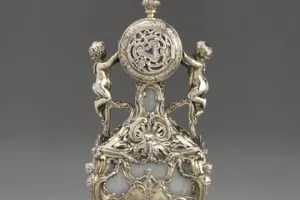CLOCK
Creator(s): Fabergé (Firm) , Henry Moser & Cie (Watchmaker) , Julius Rappoport (Workmaster)
On view in: Icon Room
About this object
As this clock demonstrates, famed Russian designer Carl Fabergé borrowed ideas not only from eighteenth-century France, but also from the English rococo. An eighteenth-century clock attributed to James Cox that reputedly belonged to Empress Alexandra (now at the Walters Art Gallery, Baltimore) might have inspired the piece in the Hillwood collection. To create the clock in the Hillwood collection, Fabergé both copied and altered details from his model. Both clocks take the form of chests of drawers, and two putti at each side support the clockworks. In addition to drawers, the Fabergé clock has side panels that open to reveal portraits on ivory of Nicholas and Alexandra. Hillwood's clock was among the treasures Fabergé displayed at the Exposition Universelle in Paris in 1900. It was then described as "A little Louis XV cabinet, given to the Dowager Empress by the late Czar, is surmounted by a clock, on the top of which is a dove in brilliants, bearing a fine pearl. It is a very handsome work of art". According to the hallmarks and its scracth (or Fabergé record) number, the clock was produced after December 1893. It was recorded as being in the Dowager Empress's blue study at the Anichkov palace in St. Petersburg in 1897. Thanks to newspaper accounts, it is now known that the clock was a gift from Alexander III to his wife, most likely to commemorate the engagement and forthcoming wedding of their son, the future Nicholas II, to Princess Alix of Hesse (Alexandra Fedorovna). Alexander III died before the wedding on November 1, 1894. Hillwood's clock may have been his last present to his wife, and it is perhaps for this reason that she particularly cherished it. "She cannot look at it without emotion," proclaimed a French newspaper in 1900.
The case is made of pale green bowenite in silver mounts. The lower portion is in the form of a two-drawer 18th century commode, resting on four lizard-shaped monsters in silver for feet. The frame of the clock-case is in silver with rococo scrolls and a protome at each corner. At the right side, an oval opens to display a miniature of the Emperor Nicholas II and at the other side, an oval covers a matching miniature of the last Empress, Alexandra Feodorovna. At the back of the commode is a silver medallion with the cipher of Maria Fedorovna, the Dowager Empress. The clock is above the commode and is supported by two putti at each side. The whole is surmounted by a bouquet of flowers in emeralds, cabochon rubies and pearls.
- Object name:
- CLOCK
- Made from:
- silver gilt -- bowenite --emerald --ruby --pearl --watercolor on ivory
- Made in:
- Saint Petersburg, Russia
- Date made:
- c. 1893
- Size:
- 28.6 × 10.2 cm (11 1/4 × 4 in.)
Detailed information for this item
- Catalog number:
- 12.155
- Class:
- SILVER
- Signature marks:
- MARK IR in Cyrillic (initials of workmaster Julius Rappoport), 88 and crossed anchors (assay mark for St. Petersburg before 1899) [On the back in rococo shell] INSCRIPTION H. Moser & Cie [On clock mechanism] SCRATCHED NUMBER 47670 [On feet]
- Credit line:
- Bequest of Marjorie Merriweather Post, 1973
























